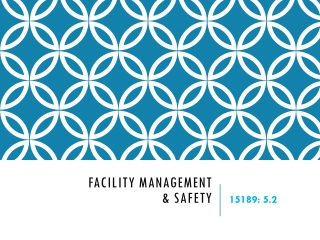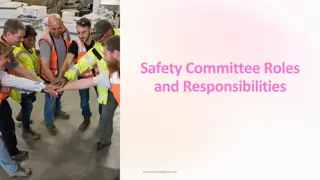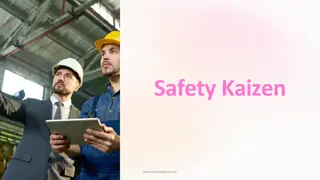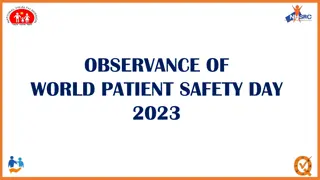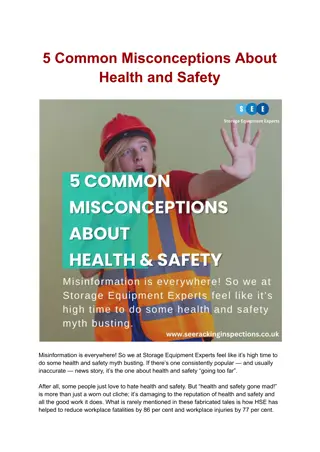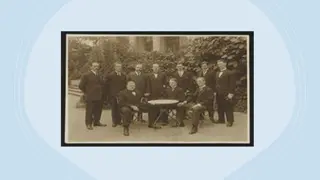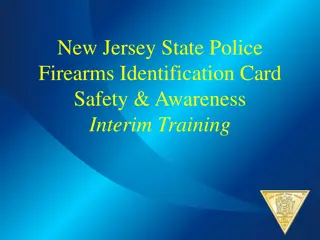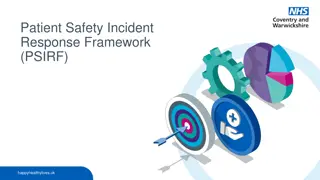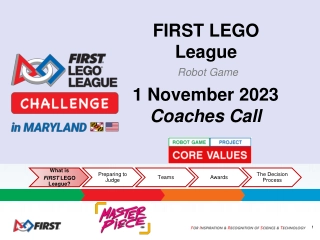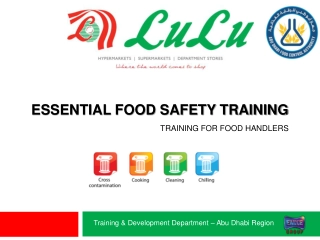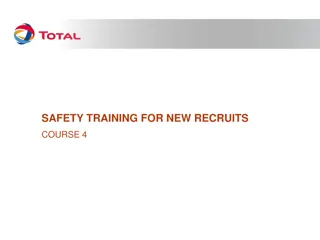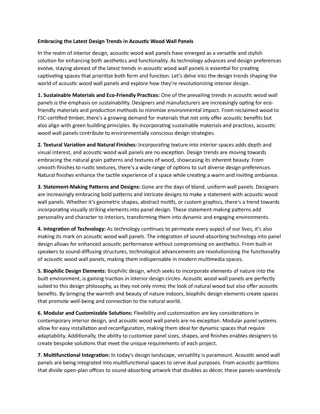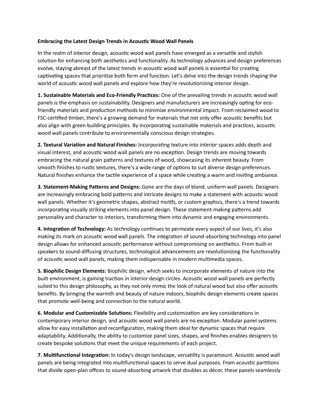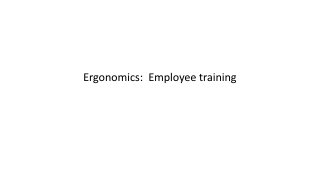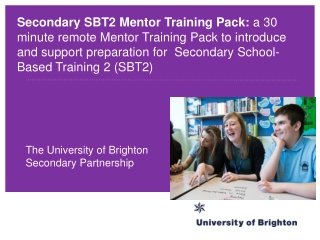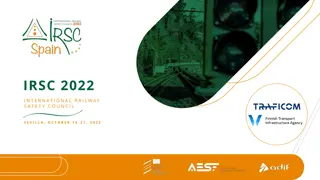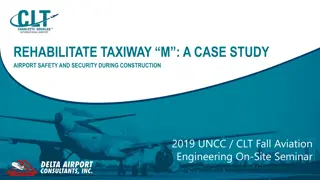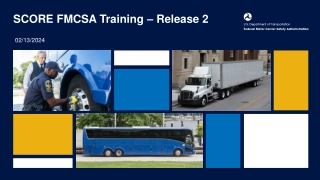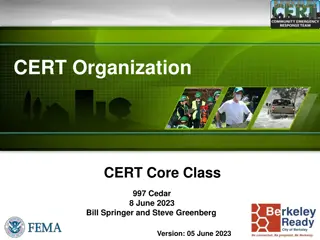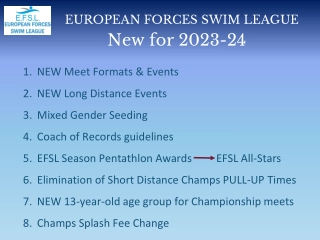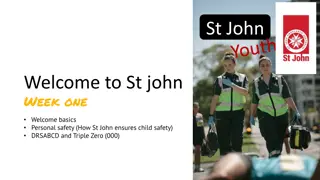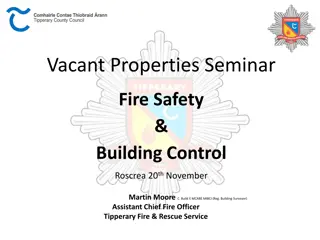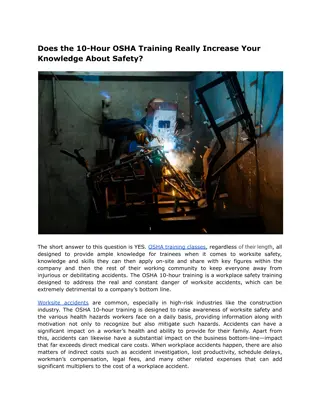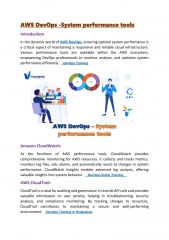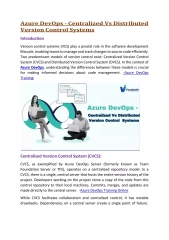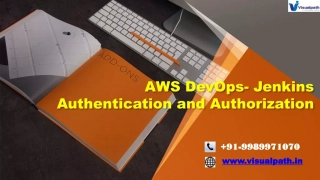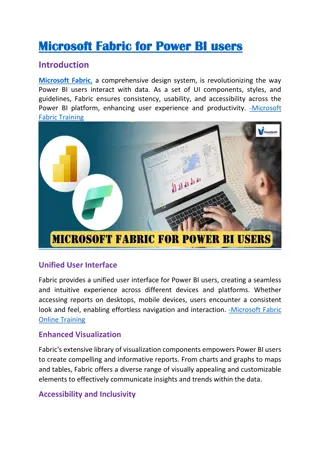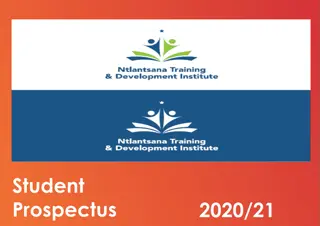Wall Little League Safety Training Overview
Wall Little League focuses on safety, first aid, and fundamental training to ensure a safe and enjoyable experience for all participants. The program covers general safety topics and emphasizes the importance of education, proper equipment use, enthusiasm, and enforcement. It also includes details about the League's Play It Safe initiative, ASAP Plan requirements, and Child Protection Program guidelines to promote a secure environment for all involved.
Wall Little League Safety Training Overview
PowerPoint presentation about 'Wall Little League Safety Training Overview'. This presentation describes the topic on Wall Little League focuses on safety, first aid, and fundamental training to ensure a safe and enjoyable experience for all participants. The program covers general safety topics and emphasizes the importance of education, proper equipment use, enthusiasm, and enforcement. It also includes details about the League's Play It Safe initiative, ASAP Plan requirements, and Child Protection Program guidelines to promote a secure environment for all involved.. Download this presentation absolutely free.
Presentation Transcript
Wall Little League Wall Little League Safety, First Aid, and Fundamentals Training League #007-90-55
Wall Little League Safety Training Wall Little League Safety Training General Safety Topics General Safety Topics Little League Safety Encompasses 4 Main Categories 1. Play it Safe 2. Safety Plan 3. Child Protection Program 4. Safety, First Aid, and Fundamentals Training 2020 WLL Safety Officer Patrick Frerich pfrerich2@gmail.com 325-277-0492
Wall Little League Safety Training Wall Little League Safety Training Play it Play it Safe Safe The purpose of Play It Safe is to provide information and counsel to League personnel on carrying out basic safety policies and making Little League a safer and more enjoyable activity. Safety practices should become routine discipline and a background reason for all activities or in other words become "safety-minded". The four "E's" of safety: EDUCATION - including suitable safety precautions in instructions, training, communications, drill work, and follow-up. EQUIPMENT - safe design, upkeep, and use of physical property, fields, personal protective equipment, bleachers, bats, balls, etc. ENTHUSIASM - the key to selling this important ingredient called safety, which can prevent painful and disabling accidents. ENFORCEMENT - applied as an incentive for skillful ball playing rather than as disciplinary action. Far better results can be obtained by praise and recognition than by forcing Players into line. Tactful guidance must be backed by firmness and justly-used discipline.
Wall Little League Safety Training Wall Little League Safety Training ASAP Plan ASAP Plan A Safety Awareness Plan (ASAP) is required by LL International for Chartered Leagues WLL s ASAP includes: 15 Requirements of LL International that must be included in ASAPs Volunteers Responsibilities Safety Policies and Procedures Safety Rules and Player Safety Tips Training Programs Safety and First Aid, Coaches, and Concussion First Aid Equipment and Injury Procedures Emergency and Accident Procedures WLL s ASAP is on the League Webpage, Emailed to all Coaches, and in the Concession Stand
Wall Little League Wall Little League Child Protection Program League #007-90-55
Wall Little League Safety Training Wall Little League Safety Training Child Protection Program Child Protection Program Child Safety and Child Abuse Awareness is very important to LL International and WLL All Volunteers must complete a Volunteer Application and Background Check Checks National Sex Offender Registry and Criminal History JDP Link emailed to you to complete Must be completed and passed before you can coach or volunteer If the Background Check is not passed, the Applicant cannot volunteer in any capacity in WLL
Wall Little League Safety Training Wall Little League Safety Training Child Protection Program Child Protection Program www.littleleague.org/player-safety/child-protection-program/ Child Abuse - A Five-Step Review to protect your Little Leaguers: 1. Know what abuse is and know where to look. Defining child abuse, and separating the truth from the myths, better enables us all to spot potentially dangerous situations. 2. Educate parents, volunteers, and children. Proper information is necessary to protect everyone. Let the children know that it s never their fault. 3. Follow the safety procedures and guidelines outlined. Employ basic rules, such as the buddy system, to limit one-on-one interactions between minors and adults. These basic rules can lessen child abuse from happening in the first place. 4. Screen applicants carefully. An effective screening process can keep potential child abusers out of our Little League programs and keep our kids safe. 5. Don t be afraid to speak out. Children and adults need to feel safe to come forward. If an individual honestly feels something is wrong, laws are in place to protect them.
Wall Little League Wall Little League Coaches and Safety Training League #007-90-55
Wall Little League Safety Training Wall Little League Safety Training Coach Responsibilities Coach Responsibilities Communicating safety rules and guidelines to Players and Parents Teaching fundamentals and safe play to Players Ensuring safe play and sportsmanship are upheld at all times Ensuring proper equipment is used by all Players during practices and games Ensuring proper protective equipment is worn appropriately Inspecting fields and removing any hazards or dangers Inspect equipment before play and removing damaged equipment Assuming duties of the Umpires if no Umpires are present (T-ball, Coach Pitch) Reporting accidents, injuries, and incidents
Wall Little League Safety Training Wall Little League Safety Training Safety Rules Safety Rules Players must wear a catcher s helmet and mask with throat guard when warming up pitchers Coaches are not permitted to warm up pitchers Helmets must be NOCSAE Approved Helmets must be worn when batting and running the bases Bats must meet USA Bat Standards for the appropriate level of play Catchers must have a cup. Other Players are encouraged to wear one as well Do not leave after games or practices until all Players have been picked up Crowding the plate will not be permitted Intentionally hitting a batter will not be permitted
Wall Little League Safety Training Wall Little League Safety Training Safety Rules Safety Rules One Coach is to remain near or inside the dugout area at all times During warm-up drills, space Players so that no one is endangered by wild throws or missed catches During warm-up drills, align Players so no one is looking into the sun No head-first slides are permitted except when returning to a base On-deck batters are not permitted ASAP Appendix I for more tips
Wall Little League Safety Training Wall Little League Safety Training Inclement Weather Safety Inclement Weather Safety Cold Weather Use the Wind Chill Clothing should not inhibit safe play No heaters in the dugout they re a fire and burn hazard Chattering teeth, uncontrolled shivering, or glazed eyes are signs a Player is too cold Temperature is relative to the individual, not to the perception of the Coach Rain Light rain is ok so-long-as the field doesn t soak The OD or other Official will determine if fields are not playable
Wall Little League Safety Training Wall Little League Safety Training Inclement Weather Safety Inclement Weather Safety Lightning Designate a Weather Monitor not a coach or umpire WLL uses a Lightning Monitor If lightning is detected within 10 miles, play must stop and everyone must leave the fields Teams may return 30 minutes after the last lightning strike Thunder can usually be heard up to 10 miles away 30 seconds between lightning and thunder = ~6 miles
Wall Little League Safety Training Wall Little League Safety Training Inclement Weather Safety Inclement Weather Safety Hot / Humid Days Stay cool and hydrated; Use cool wraps No way to hydrate = No play Be extra mindful to Players and attend to any Player that appears too hot If a Player is thirsty, they re already dehydrated Heat Exhaustion stopped sweating, dizzy, nauseous, weak or dazed. Ask parents if their kids have ever had Heat Exhaustion
Wall Little League Safety Training Wall Little League Safety Training Inclement Weather Safety Inclement Weather Safety Monitoring the Weather Stations: KLST, KSAN, Fox News Online: National Weather Service, NOAA, The Weather Channel Apps: The Weather Channel, AccuWeather, WeatherBug Use a combination of these for improved accuracy
Wall Little League Wall Little League First Aid Training League #007-90-55
Wall Little League Safety Training Wall Little League Safety Training First First Aid & Fundamentals Requirements Aid & Fundamentals Requirements ASAP Requirement #5 - Fundamentals Training ASAP Requirement #6 - First Aid Training LL International requires that each team have a minimum of one Coach participate in and complete First Aid and Fundamentals Training before the start of the current season First Aid and Fundamentals Training must be refreshed every 3 years
Wall Little League Safety Training Wall Little League Safety Training First Aid First Aid Remain Calm! Administer Aid Always seek Trained Professionals for help. There s probably a parent on your team who s trained. Ask / identify who they are when the season starts. First Aid Kits are in the Storage Containers and Concession Stand Emergency Procedures and Emergency Contacts are in the Scorekeepers Boxes and Concession Stand
Wall Little League Safety Training Wall Little League Safety Training First Aid First Aid Cuts and Scrapes Minor Injuries Clean the wound Stop the bleeding Apply antibiotic Cover the wound Stitches for deep wounds RICE REST the injury ICE the area COMPRESS the bandage ELEVATE to prevent swelling
Wall Little League Safety Training Wall Little League Safety Training First Aid First Aid Head Injuries Call 911 Do not move an unconscious person Perform CPR if necessary Be aware of concussions Black eyes require gentle pressure with cold pack Use clean water to rinse foreign bodies out of the eye Sprains and Strains Most respond to rest & ice With immediate swelling / deformed limb, immobilize if you know how to do so If a popping sound was heard, the ligament may be torn requires emergency evaluation
Wall Little League Safety Training Wall Little League Safety Training First Aid First Aid Communicable Disease Procedures Communicable Disease one that can be transferred through the exchange of bodily fluids blood, saliva, etc. Protection Use Gloves and other PPE Immediately wash hands Remove contaminated clothing Properly dispose of items Bleeding must be stopped and wound must be covered before the athlete can continue play. If excessive blood is on the uniform, it must be changed before continuing play
Wall Little League Safety Training Wall Little League Safety Training Concussion Training Concussion Training If a concussion is suspected: Remove Player from play Seek Medical Attention Inform and Educate Parents Online Training Course for Coaches https://headsup.cdc.gov/
Wall Little League Wall Little League Emergency Procedures and Accident Reporting League #007-90-55
Wall Little League Safety Training Wall Little League Safety Training Emergency Procedures and Contacts Emergency Procedures and Contacts Emergency Contact Information and Emergency Procedures are mounted in Scorekeepers Boxes and on Concession Stand
Wall Little League Safety Training Wall Little League Safety Training Accident and Incident Reporting Accident and Incident Reporting Accidents and incidents/close calls must be reported Prompt Accident Reporting Alert the OD OD will collect necessary information about the injured Player and incident Report to Safety Officer within 24 48 hours Injured Players may require a doctor s release to return to play
Wall Little League Safety Training Wall Little League Safety Training Accident and Incident Reporting Accident and Incident Reporting Accident Forms In Appendix H of ASAP Safety Officer will complete OD or Coach should gather names of player, parents contact information, and incident information Safety Officer will contact parents with additional information and options
Wall Little League Wall Little League Fundamentals Training League #007-90-55
Wall Little League Safety Training Wall Little League Safety Training Fundamentals Training Fundamentals Training Key Points to Remember: Practices should start with the basics Evaluate Player s individual skills Use progressive drills to improve from the Player s baseline. This is likely to be different levels for each Player Don t ignore undeveloped Players. Rather, provide extra attention to quickly improve their skills Encourage practice at home. Provide drills to Players and Parents to use at home.
Wall Little League Safety Training Wall Little League Safety Training Fundamentals Training Fundamentals Training What: How Throwing Catching Batting Base Running Sliding Infield Play Outfield Play Pitching and Catching Skills Efficient practices Multiple stations and rotations Keep it fun Provide appropriate guidance Focus on development, not winning Be a Student as well as a Coach Teach the right way to throw, catch, etc.
Wall Little League Safety Training Wall Little League Safety Training Fundamentals Training Fundamentals Training It s the Coach s responsibility to ensure Players are getting the teaching, skills, and practice that they need to develop as ball players. www.littleleague.org/university/coaches/ Drills Tips Rules Practice Plans www.littleleague.org/teeball www.littleleague.org/coachpitch


